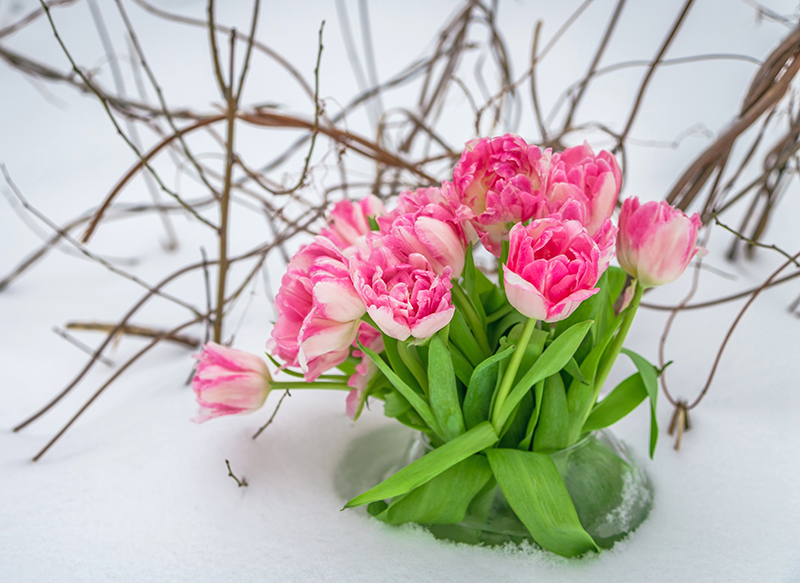Let Peony Flowers Speak: Colour Meanings and Symbolism in Full Bloom
Peony flowers are much more than just a stunning addition to gardens and bouquets. Renowned for their lush, full blooms and enchanting fragrance, peonies have captivated people across the world for centuries. Their history, symbolic meanings, and the powers attributed to their vibrant colors have turned the humble peony into one of the most celebrated and meaningful flowers. In this article, let's dive deep into the beautiful symbolism of peony flowers, unraveling the mystery of their color meanings and the messages they convey in full bloom.
Discovering the Peony: A Brief Botanical Introduction
The peony is a perennial flowering plant found predominantly in Asia, Europe, and North America. With over 30 species and thousands of cultivars, their blossoms range from crisp whites and gentle pastels to vivid pinks, reds, and exotic yellows. Their botanical name, Paeonia, stems from ancient myth, associating the flower with healing and prosperity.
Origins and Cultural Significance
Originally cultivated in China over 2,000 years ago, peony flowers are synonymous with riches, elegance, and honor. They are often referred to as the "king of flowers" in Chinese culture and feature prominently in art, literature, and wedding ceremonies. In Western countries, peonies have come to symbolize romance and prosperity, making them a popular choice for bridal bouquets and festive occasions.

The Language of Peony Flowers: What Do They Symbolize?
Like many other flowers, the peony has developed its own language over centuries. From the elaborate courts of the Ming dynasty to the sentimental Victorians, every era has contributed its own layer to the rich symbolism of this blossom. Peonies generally represent:
- Prosperity and abundance
- Romance and love
- Honor and respect
- Beauty in all forms
- Good fortune and happy marriage
But as we shall see, the meaning of a peony flower can change significantly depending on its color.
The Colour Palette of Peonies and Their Secret Messages
One of the reasons peonies are so beloved is their diverse color range. Each shade carries its own special meaning, making peonies ideal for conveying unspoken sentiments. Let's explore the most popular peony flower colors and the symbolism behind them.
Pink Peonies: Symbols of Romance and Joy
Perhaps the most famous peony shade, pink peonies are adored for their delicate beauty and soft charm. Pink peony flowers generally symbolize:
- Romantic love - Often exchanged between lovers.
- Happiness and good fortune - Associated with successful marriages and happy homes.
- Grace and youthfulness - The gentle color invokes a sense of renewal and joy.
Pink peonies are popular choices for wedding bouquets and anniversary gifts, making them a timeless symbol of undying affection.
White Peonies: Purity, Innocence, and New Beginnings
White peonies embody purity and innocence. They often star in springtime arrangements and are perfect for marking new beginnings such as weddings, births, or even a new job. White peony flowers also symbolize:
- Apology and regret - In some cultures, they signify a heartfelt apology or a wish for forgiveness.
- Elegance and class - Their simple beauty has charmed poets and artists throughout history.
If you want to say, "I'm sorry" or wish someone luck as they embark on a new journey, white peonies are the quintessential choice.
Red Peonies: Love, Respect, and Honor in Full Bloom
Red peony flowers burn with passion, carrying powerful cultural connotations in China and beyond. The vibrant red shade symbolizes:
- Respect and admiration
- Honor - Particularly associated with nobility and high status.
- Beauty and bravery
- Deep romantic love
Red peonies make meaningful gifts for elders, mentors, or anyone you deeply respect. Their bold statements are ideal for celebrating major milestones or expressing intensifying romantic feelings.
Yellow Peonies: Hope, Good Luck, and New Horizons
Yellow peonies are rare and exotic, making them instantly eye-catching. The color yellow in flowers traditionally represents joy and optimism, and yellow peony flowers also symbolize:
- Good luck and fortune
- Prosperity and growth
- A fresh start or new chapter
Because of these bright associations, yellow peonies are perfect for graduation celebrations, new business ventures, or simply wishing someone well as they move forward in life.
Purple and Lavender Peonies: Mystery, Fame, and Uniqueness
Purple and lavender descriptors are often used interchangeably, but both shades of peonies are associated with mystery and wonder. Purple peonies symbolize:
- Success and honor - Often depicted in art to represent royalty or divine favor.
- Unique beauty and charisma
- Enchantment and mystery
Purple peonies are an elegant way to celebrate a special achievement or to let someone know they stand out from the crowd.
Coral Peonies: Passion, Energy, and Renewal
Coral peonies, with their radiant mix of orange and pink, are especially vibrant. This dynamic color represents:
- New beginnings ~ Perfect for graduations or life changes.
- Energy and enthusiasm
- Desire and passionate love
Coral peonies add a modern twist to bouquets, infusing any occasion with a feeling of excitement and rejuvenation.
Peony Color Meanings Across Cultures: A Global Perspective
The language of flowers, including peony symbolism, has evolved differently around the world, but universal themes of love, luck, and honor remain constant.
Peonies in Chinese Culture
More than any other country, China is where the peony flower holds royal status. Considered the "flower of riches and honor", it graces imperial palaces, fine art, and weddings. In the Chinese tradition, peony colors carry subtle but important meanings:
- Red peonies symbolize honor, wealth, and respect.
- Pink peonies are auspicious, representing luck and a happy marriage.
- White peonies are linked to fulfillment and purity.
Peonies are also used in Feng Shui practices to invite love and prosperity into the home.
Japanese Peony Symbolism
In Japan, peonies express bravery, good fortune, and a fulfilling marriage. Known as the 'King of Flowers', they often appear in tattoos and paintings as a symbol of elegance and strength. Their association with honor makes them popular for significant life events and rituals.
Western Interpretations
In the West, peonies are most commonly associated with romance, happiness, and prosperity. The Victorian "language of flowers" attributed meanings similar to those found in China, with pink and red peonies strongly linked to love. Over time, they have become a favorite for bridal arrangements, anniversaries, and festive decor.
How to Choose the Right Peony Colour for Every Occasion
The next time you select peony flowers for a bouquet, arrangement, or garden, consider their color symbolism to make your gift even more meaningful. Here are some helpful suggestions:
- Weddings & Anniversaries: Opt for pink peonies to symbolize love and good fortune, or white for purity and new beginnings.
- Graduation & Milestones: Choose yellow or coral peonies for energy, new opportunities, and luck.
- Gifts of Respect: Present red or purple peonies to express admiration and honor for someone special.
- Apologies & Reconciliation: White peonies express heartfelt regret or the hope for a renewed relationship.
- Spreading Joy: Any peony color will uplift spirits, but yellow and coral bring a radiant burst of cheerfulness.
Peony Mythology and Folklore: Legends Behind the Petals
The symbolism of peony flowers isn't just rooted in color; it is embedded in fascinating myths and stories.
The Greek Myth of Paeon
According to Greek mythology, the peony is named after Paeon, a student of the god Asclepius. When Paeon's healing abilities made his mentor jealous, Zeus transformed Paeon into a peony flower to protect him. This tale cemented the peony's reputation as a flower linked to healing and protection.
Peonies as Omens and Charms
In medieval Europe, peony seeds were believed to ward off evil spirits. In China, peonies have long been regarded as a sign of good omens, bringing luck and marital bliss to a household. Even today, many still believe that planting peonies in the garden invites abundance and ensures happiness for generations.

Cultivating Peonies: Growing Whispers of Meaning in Your Garden
If you'd like to let peony flowers speak for themselves, consider planting them in your own garden. Not only do they add beauty and fragrance, but with their rich color meanings and symbolism, they turn any plot of earth into a tapestry of emotion and tradition.
Essential Tips for Growing Peonies
- Choose the Right Location: Peonies love sunny spots with well-drained soil.
- Plant in Fall: Bare root peonies should be planted in autumn for the best results.
- Water Wisely: Avoid waterlogging the roots, which can cause rot.
- Support the Blooms: Full flowers sometimes need stakes to hold up their heavy heads.
- Patience Pays Off: Peonies may take a couple of years to bloom but reward you with beauty for decades.
Whether in a vase or beneath your window, your peony colors will send their subtle messages every spring and summer.
Conclusion: Let Peony Flowers Speak Volumes
Peony flowers are more than a fleeting pleasure; they're a living language, a bridge between history, culture, and heartfelt sentiment. The meanings of peony colors -- from passionate reds to hopeful yellows -- allow you to say so much, whether you're gifting them to loved ones or adorning your home. By understanding and appreciating the symbolism behind each hue, you can let peony blossoms do the talking, expressing your feelings in a way that words sometimes fall short. When next you encounter a peony in full bloom, pause for a moment -- and let its silent message, centuries in the making, speak straight to your heart.
With every petal, peony flowers whisper tales of romance, prosperity, and hope. Embrace their language, and let your next bouquet carry a message that blooms long after the petals have fallen.

